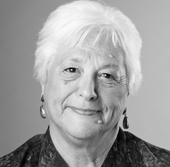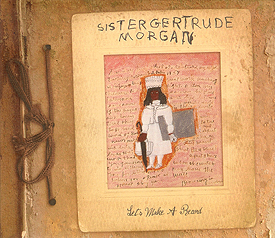
Sharon Litwin (photo by Jason Kruppa)
Editor’s Note: In honor and memory of Sharon Litwin, The Queen here at NolaVie, we will be publishing a piece from her every day for the next month. Sharon was an advocate and spokeswoman for arts, culture, people, and policies here in New Orleans. Her voice and sharp wit will be greatly missed.
To hear Sharon Litwin interview William Fagaly on WWNO public radio, click here.

Sister Gertrude Morgan’s ‘Let’s Make a Record’ is available for purchase online at preservationhallmerch.com.
Last week, a very nice young man came to my house to do some repairs. He saw some of the artwork on the walls of my living room, and mentioned that he had just come from another home where he thought at least one of the paintings was something he could have done himself. He was impressed, not by the painting so much, since he was already of the opinion he could do at least as well, but by what he was told it was worth.
As you have probably figured out, what he saw was a piece of folk art — almost childlike, bright in color and, to his mind, hardly worth the framing. But to those who recognize the honesty and spirituality found in such unique expressions, they are extraordinary. And to the countless collectors who gather such works, they are precious and now have become extremely valuable.
The formal art world took a long time accepting folk art as something worth considering. In fact, the first comprehensive retrospective exhibition of one of the nation’s most famous folk artists – New Orleans’ own Sister Gertrude Morgan – was held as recently as January 2005. It was organized by William A. Fagaly, formerly Assistant Director for Art at the New Orleans Museum of Art, and still the Francoise Billion Richardson Curator of African Art.
Forty-five years is a powerful length of time to go to work daily in the same place, but that’s what Bill Fagaly has been doing. Over the years, he has watched all kinds of art movements flourish and fade. But because he is enchanted not only by outsider art, but even more so by those who create it, he has worked hard and long to ensure it achieves academic acceptance.
Bill does not like the word “discovered” in describing emerging artists, but like it or not he really is the one who … well, that D word …. the remarkable works of Sister Gertrude Morgan, a street preacher-cum-missionary-cum-artist-cum-poet. And while she is no longer with us, her work still is, in countless private collections and museums across the country. There is even a CD available of a record made in 1970 called Let’s Make a Record, an a cappella gospel collection of her singing accompanied by her tambourine.
Born in Alabama in 1900, Sister Gertrude Morgan came to New Orleans when she was in her 30s. She opened an orphanage with two other women, preached on the streets of the city she called “the headquarters of sin,” and established her missionary headquarters in a small house in the Lower Nine. There, in the place she called her Everlasting Gospel Mission, she painted her depictions of scriptures from the Old and New Testaments, held services, warned people of the never-ending presence of evil, and preached the word of the Lord 24/7.
Sister Gertrude Morgan died in 1980 at the age of 80. She was buried in an unmarked grave in Providence Memorial Park, Metairie. It was something that always distressed Bill Fagaly, bothered him for years, in fact. Finally, he decided to act on it. So he went to the cemetery office and located the exact site of her grave. Then he went about raising money from collectors and sympathizers to mark it with a brass plaque. When it was made, he invited friends and admirers and collectors from across the nation to a special graveside service. And, finally, in 1997, on April 7th, Sister Gertrude’s birthday, to the accompaniment of the Preservation Hall Band, she received the jazz funeral she deserved.
The South has given the world many amazing folk artists. Some have risen to world fame; others not so much. But to them, that doesn’t matter; for, like Sister Gertrude, their work is a heavenly calling.
I think that’s quite wonderful. And, no I couldn’t do that; and neither could the young man who came to work on my house.
Sharon Litwin writes Culture Watch, about New Orleans culture, weekly for NolaVie.
 NOLAbeings Multimedia artist Claire Bangser created NOLAbeings as a portrait-based story project that marries...
NOLAbeings Multimedia artist Claire Bangser created NOLAbeings as a portrait-based story project that marries...  Voodoo in New Orleans: Reviving history: New Orleans fortune telling This article takes a deep dive into the history of Voodoo in New Orleans, its hybridization with Catholicism, and its present-day place in the city's culture. The author visits fortune-tellers in the French Quarter, using their guidance as a tool for introspection rather than a deterministic predictor of the future. Through her experiences in New Orleans, the author feels a mystical connection to both the past and the future.
Voodoo in New Orleans: Reviving history: New Orleans fortune telling This article takes a deep dive into the history of Voodoo in New Orleans, its hybridization with Catholicism, and its present-day place in the city's culture. The author visits fortune-tellers in the French Quarter, using their guidance as a tool for introspection rather than a deterministic predictor of the future. Through her experiences in New Orleans, the author feels a mystical connection to both the past and the future. 